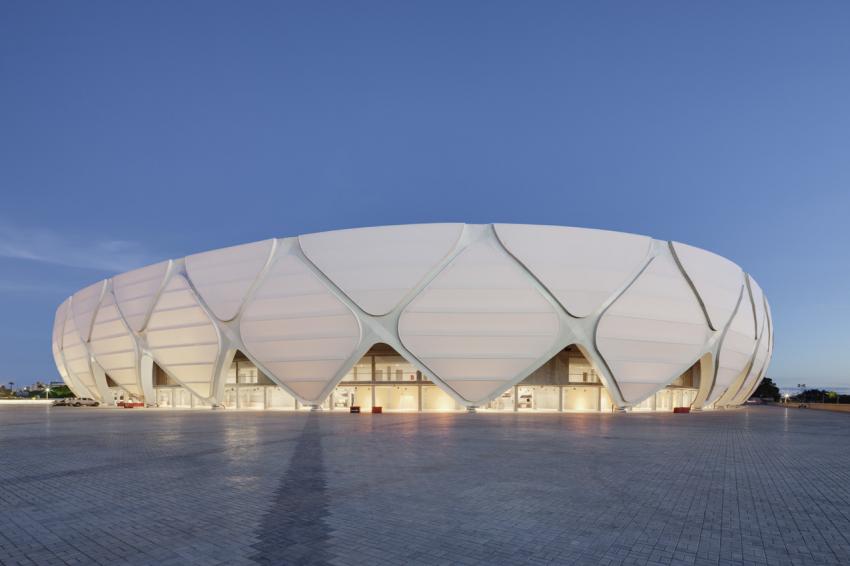Arena da Amazônia in Manaus: Kick-off at the Equator
Fibreglass membranes coated with 3M Dyneon PTFE protect players and spectators from the tropical sun
The final stage of the FIFA World Cup has never before been held as close to the equator as it will be in 2014. The latitude of the venue in Manaus is a mere 3 degrees south. Making use of lightweight textile architecture, the newly constructed Arena da Amazônia provides the best possible protection from the sun and optimum ventilation. The design of the structure's roof and facade called for 52,000 square metres of glass cloth. The fibreglass membranes are coated with 3M Dyneon PTFE, a high-performance material, to ensure long-lasting protection - even in the tropical climate of Manaus in the South American rainforest.
With 165 days of rain a year and situated at the heart of a thousand square kilometres of tropical rainforest, Manaus is nevertheless one of the wealthiest cities in Brazil. Previously, the main point of interest for architecture fans in this city of two million inhabitants in the state of Amazonas was the Teatro Amazonas. Whereas this world-famous opera house attracts attention on account of its European Renaissance style, the stadium, designed by Berlin-based architectural firm gmp Architekten von Gerkan Marg und Partner, draws its inspiration from the jungle. The supporting structure for the 35-metre high textile roof is modelled on the veins of leaves. The steel beams are designed as box girders, open at the top to channel the tropical rainfall. And to protect the 44,000 or so spectators from direct sunlight, the roof transitions seamlessly into a facade covering.
Ceno Tec GmbH from Greven, Germany, specialists in textile architecture, created 252 tailor-made sections for the Arena da Amazônia, using 52,000 square metres of fibreglass membranes coated with Dyneon PTFE. The real challenge: the individual membrane sections needed to be incredibly accurately dimensioned on leaving the factory, as it was not possible to carry out any significant adjustment work at the construction site. Ceno Tec installed the membranes during the difficult conditions of the rainy season. The translucent membranes protect players and spectators from direct sunlight, diffusing the light in an attractive manner.
The membranes, manufactured and coated by Verseidag Indutex GmbH, based in Krefeld, Germany, are made from glass cloth with a tensile strength of up to 10,000 N/5 cm. Coating the membranes with the high-performance material Dyneon PTFE achieves an elongation at break of up to 600 per cent and protects the cloth against UV rays, humidity and other environmental effects. This high-performance material has been used in textile architecture for several decades and has proven to be extremely durable. One key advantage of the coating, particularly relevant in a tropical climate, is its almost universal resistance to environmental effects and to chemicals of all types. PTFE belongs to the fluoropolymer family and needs no plasticisers or stabilisers, which can evaporate over time leading to brittleness of the coating. This means that, even after decades of use in a tropical environment, there are no cracks in which bacteria and fungi can lodge. At the same time, the surface is so smooth that it virtually cleans itself during a rainstorm.
The Arena da Amazônia is one of the first stadiums to have been certified under the criteria of the US Green Building Council's LEED programme (Leadership in Energy and Environmental Design). This holistic ecological approach takes into account the entire life cycle of buildings, including the structural materials. Dyneon PTFE fits well into this philosophy as the coating is fully recyclable, therefore making a contribution to sustainability.





